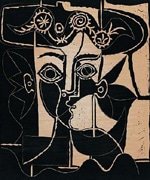Pablo Picasso BIOGRAPHY

Early Life and Artistic Beginnings
Pablo Diego José Francisco de Paula Juan Nepomuceno María de los Remedios Cipriano de la Santísima Trinidad Ruiz y Picasso, known as Pablo Picasso, was born on October 25, 1881, in Malaga, Spain.
From a young age, he showed exceptional artistic talent, drawing and painting under the guidance of his father.
His father, Don José Ruiz y Blasco, was an esteemed painter specializing in realistic depictions of birds and games, while his mother was María Picasso y López.
A Passion for Art from an Early Age
From a young age, Picasso showed an exceptional passion and talent for drawing. At the age of seven, he received formal artistic training from his father in figure drawing and oil painting.
A Move to A Coruña and a Legendary Tale
In 1891, the family moved to A Coruña, where Picasso’s father became a professor at the School of Fine Arts. A famous anecdote emerged during this time, where the young artist supposedly painted over his father’s unfinished pigeon sketch with such precision that it convinced Ruiz to abandon his own artistic pursuits.
A Journey to Madrid and New Inspirations
At the age of 16, Picasso embarked on a journey to Madrid’s Real Academia de Bellas Artes de San Fernando, Spain’s leading art school. However, he soon grew disenchanted with formal instruction and chose to explore the vibrant city of Madrid instead.
The masterpieces housed in the Prado Museum, especially those by Diego Velázquez, Francisco Goya, and El Greco, left a lasting impression on the young artist, influencing the evolution of his own distinctive style.
Despite his initial disinterest in formal education, Picasso’s early years laid the foundation for an unparalleled artistic journey that would redefine the boundaries of art and forever change the course of modern art history.
What is Pablo Picasso known for?

Pablo Picasso, the iconic Spanish artist, is renowned for his extraordinary contributions to the world of visual arts. As a painter, sculptor, printmaker, and ceramicist, he played a pivotal role in shaping 20th-century art.
Career highlights

The Move to Paris and the Blue Period
In 1901, Picasso moved to Paris, the epicenter of the art world at the time. During this period, he experienced poverty and hardship, which influenced his work, leading to what is known as the “Blue Period.”
Characterized by somber and melancholic themes, the paintings of this period are predominantly rendered in shades of blue, reflecting Picasso’s emotional and psychological struggles.
The Rose Period and Artistic Exploration
Around 1904, Picasso’s color palette shifted, and he entered the “Rose Period.” This phase was marked by warmer colors and a focus on circus performers and acrobats. His art during this period conveyed a sense of joy and optimism, showcasing a new direction in his artistic exploration.
Cubism: A Revolutionary Movement
In 1907, along with Georges Braque, Picasso co-founded Cubism, an art movement that would reshape the course of modern art. In the initial phase of Cubism, known as Analytic Cubism, the artists deconstructed objects into complex geometric forms, presenting multiple perspectives simultaneously.
Synthetic Cubism and the Introduction of Collage
Picasso further developed Cubism into the Synthetic Cubism phase, which emerged around 1912. During this period, he began introducing collage elements into his work, incorporating everyday objects and materials into his paintings.
Pablo Picasso List of Work

Masterpieces and Iconic Works
Throughout his prolific career, Picasso created numerous masterpieces that have become iconic in the art world. Some of his most famous works include:
- “Les Demoiselles d’Avignon” (1907), a groundbreaking and controversial painting that heralded the Cubist movement
- “The Weeping Woman” (1937), a powerful portrayal of grief and sorrow during the Spanish Civil War
- “Les Meninas” series (1957), which reimagined Diego Velázquez’s famous work in a Cubist context.
Exploration of Different Artistic Mediums
Picasso’s artistic versatility extended beyond painting. He ventured into sculpture, ceramics, and printmaking, showcasing his talent and innovation across various mediums.
His sculptures, in particular, demonstrated a profound understanding of form and space, and he experimented with unconventional materials to create dynamic and expressive works.
Guernica: A Symbol of Anti-War Activism
One of Picasso’s most significant and powerful works is “Guernica,” created in response to the bombing of the Basque town of Guernica during the Spanish Civil War.
Completed in 1937, this monumental painting stands as a powerful anti-war statement, depicting the horrors of conflict and the suffering of innocent civilians.
Legacy and Lasting Influence
Pablo Picasso’s influence on the art world is immeasurable. His revolutionary approach to art, his ability to continually reinvent his style, and his unyielding pursuit of new artistic forms have left an indelible mark on modern art. Picasso’s work continues to inspire generations of artists, and his name is synonymous with artistic innovation and creative expression.
The End of an Era
Pablo Picasso passed away on April 8, 1973, in Mougins, France. His death marked the end of a storied career that forever changed the landscape of art.
Picasso’s legacy endures through his groundbreaking contributions, making him one of the most celebrated and revered artists in the history of contemporary art.
Picasso Enters the NFT Boom: A Bridge Between Worlds
The legacy of the legendary artist Pablo Picasso continues to make waves in the art world, now venturing into the realm of NFTs. Picasso’s granddaughter, Marina Picasso, along with her son Florian Picasso, is set to release 1,010 non-fungible tokens (NFTs) of a previously unseen painted ceramic bowl.
The NFTs, representing Picasso’s unique work, will open for online sales on platforms Nifty Gateway and Origin Protocol.
More about Pablo Picasso
Visit the official website to explore the full list of Picasso’s works and stay informed about any recent updates.












